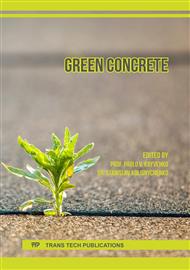p.233
p.241
p.246
p.254
p.260
p.266
p.273
p.278
p.282
Behavior of Concrete Containing of Fine Recycled Aggregate
Abstract:
The use of coarse recycled aggregate in concrete is already accepted in the Czech Republic but with specific restrictions. The problem is the use of fine recycled aggregate (FRA) in concrete. This paper is focused on behavior of concrete containing FRA. FRA, which originated from recycling plant in the Czech Republic, was used in an experimental part. FRA was obtained from demolished and crushed concrete structures. Four concrete mixtures were designed and prepared. The first concrete mixture was reference which did not include FRA. Natural sand was replaced by FRA in other concrete mixtures in varying ratio. There were tested physical, mechanical and deformation properties of concrete. According to test results it is possible to say that the use FRA as partial replacement of natural sand in concrete mixtures.
Info:
Periodical:
Pages:
260-265
Citation:
Online since:
January 2016
Authors:
Price:
Сopyright:
© 2016 Trans Tech Publications Ltd. All Rights Reserved
Share:
Citation:



